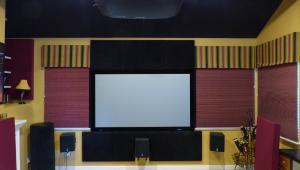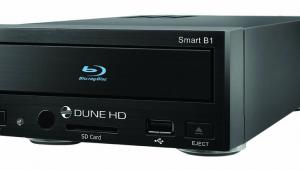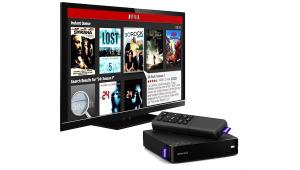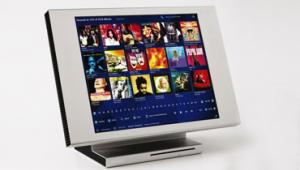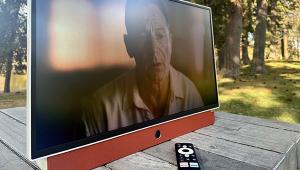A DVD Christmas
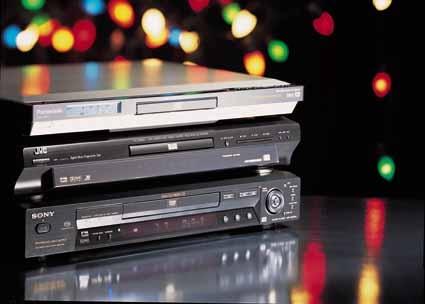
Like Santa descending a chimney every year with an ever-larger bag of goodies, DVD players have been coming down in price while their bundles of features have expanded. This holiday season you can get all three of the hottest features-a progressive-scan video output, multichannel DVD-Audio or Super Audio CD playback, and playback of MP3 and other compressed-audio formats-in the same reasonably priced player. In fact, to see just how much you can get for your money, we picked low-priced players with those major features from three manufacturers: JVC's XV-SA600 ($300), Panasonic's DVD-XP50 ($350), and Sony's DVP-NS755V ($300).
Since the players are so close to each other in price, they're more or less equally matched when it comes to other features as well (see the table on page 108), but there are a few highlights. The JVC offers the most options for optimizing the DVD image on your TV. Beyond the four basic picture controls (brightness, contrast, color, and hue), it has controls for sharpness and gamma-the latter can have a tremendous influence on picture quality if your TV isn't based on cathode-ray tube (CRT) technology, meaning that it has an LCD, plasma, or other type of display. The JVC is also the only model in this group offering playback of JPEG-format digital still images stored on disc. It has the easiest-to-use remote control, too, with glow-in-the-dark buttons (none of the three is backlit). The Sony's remote is the next easiest to use, while the Panasonic's disc-control buttons are small and crammed too closely together.
What Format Wars?
There are several format disputes raging around the DVD. The two most relevant here are the ones over recordable DVD, with three choices-DVD-R/RW, DVD+R/RW, and DVD-RAM-and over multichannel high-resolution audio, with two choices-DVD-Audio and SACD (although, strictly speaking, SACD is not a type of DVD). If we had a truly universal player capable of playing all types of recordable DVD, there would be no recordable-DVD format war, at least when it comes to playback. Unfortunately, the manuals for each of these players have long lists of the disc formats they don't support. But one of the pleasantly surprising findings of our tests was that a couple of these players could actually read discs that their manuals said they couldn't.
Both the JVC and Panasonic handled DVD-R/RW discs recorded in standard DVD-Video format and DVD+R/RW discs. The Panasonic and Sony players even did the JVC one better in being able to handle DVD-RW discs recorded in that format's editable VR mode. Since the Panasonic could also play DVD-RAM discs ("naked" discs, not those in protective caddies), it can be considered a universal DVD-Video player, followed closely by the Sony if DVD-RAM compatibility is not required. While neither we nor any player or recorder manufacturer will guarantee that every disc in any format will play in all players (we tried at most two samples of each type for our tests), this is still good news if you have a DVD recorder or computer DVD burner, or already have technologically advanced relatives and friends sending you homemade DVDs. With either the Panasonic and Sony among this trio, it's likely that you'll be able to play them.
The number of multichannel-audio players capable of handling both DVD-Audio discs and SACDs is still small and doesn't include any of these three models. The closest thing to a universal A/V player here would be the Sony DVP-NS755V, since in addition to being the only one able to play multichannel SACDs (the other two played only the CD-compatible stereo tracks on hybrid SACDs), it will also handle the parallel-universe Dolby Digital multichannel soundtracks included on nearly every DVD-Audio title specifically to make them compatible with "normal" (non-DVD-Audio) players. You won't get true 96-kHz/24-bit DVD-Audio resolution when playing the Dolby Digital tracks on a DVD-Audio disc, but you'll get at least 90% of the sound quality and better system-setup functions (bass management and speaker-distance compensation).
We usually consider virtual surround sound processing, which simulates multichannel playback using only two speakers, as a poor substitute for an actual surround sound system. But the Sony player's virtual surround processing proved unusually versatile-it lets you adjust the "placement" of the virtual speakers-and was sometimes quite convincing in sound quality, especially with movie sound effects, as in the entertaining and instructive sound-effects-only alternate soundtrack of Monsters, Inc. However, as usually happens with virtual surround systems, the surround sound field quickly collapsed whenever I moved away from the sonic sweet spot.
Codec the Halls
Santa would consider extremely naughty any recent DVD player that did not offer playback of MP3 compressed-audio files on disc. All three players under consideration are therefore "nice," since they could handle MP3 files at bit rates from 64 kilobits per second (kbps) up to the MP3 maximum of 320 kbps as well as very high-quality variable bit rate files recorded on computer CD-R/RWs. Nicest was the JVC, since it could also handle such files when they were recorded on DVD-RW, a format that offers the prospect of storing the music from more than 70 CDs on a single disc.
 | |
| JVC XV-SA600 DIMENSIONS: 17 1/4 inches wide, 2 3/4 inches high, 10 5/8 inches deep PRICE: $300 www.jvc.com |
We received the Panasonic player just after Microsoft introduced its latest WMA formats, the Windows Media 9 Series (WM9S). Unfortunately, the DVD-XP50 was probably designed a bit too early to handle any of these new formats, none of which it could play (I was looking forward to "lossless" and multichannel WM9S playback). It did, however, play "old style" (WMA8) constant- and variable-bit-rate files, right up to the maximum bit rates that stereo WMA encoding allows. As is almost always the case, all three players introduced audible gaps-usually more than a second-between compressed-audio tracks that had been contiguous on the original CDs, spoiling the enjoyment of things such as MP3- or WMA-encoded operas and live rock concerts. (Neither the Panasonic nor the JVC, I'm happy to say, suffered from the similar inter-track gap problem in DVD-Audio playback that has afflicted other players I've tested.)
Progressive Sugar Plums
Progressive-scan is perhaps the hottest of new DVD player features, probably because when a progressive-scan video signal is fed to a compatible TV, the result is (or should be) an extremely smooth, filmlike picture, with visible scan lines greatly reduced or even eliminated. In high-quality program material, the images can be quite stunning, second only to true HDTV. The quality of progressive-scan conversion can vary widely, however, and it does among these three players.
 | |
| Panasonic DVD-XP50 DIMENSIONS: 17 inches wide, 2 1/8 inches high, 11 7/8 inches deep PRICE: $350 www.panasonic.com |
In progressive-scan reproduction of 24-frame-per-second film material (both movies and test patterns), the Panasonic had the fewest common conversion artifacts, including smeared colors, jagged diagonals, anomalies on sudden motions or scene transitions, and visible scan lines or roughness. The JVC was equally good on movies-Monsters, Inc. looked particularly good-and almost as good on the new test patterns. The Sony's progressive-scan output was not nearly as clean looking on either movies or test patterns. For example, at the beginning of Chapter 16 of the full-screen version of Monsters, Inc., the movements of Sulley's head produced momentarily visible scan lines that weren't apparent with the Panasonic or JVC. Progressive-scan performance with material that originated on video (as opposed to film) was not as clean with any of these players-it's tougher to do-but the ranking remained the same.
Surrounded by Reindeer
Despite easily measurable differences in their noise levels, which limit resolution (see "In the Lab," page 112), all three players did an outstanding job of reproducing multichannel DVD-Audio discs or SACDs when they were connected to a suite of five large speakers optimized for music playback (monopole surrounds at ear level). Discs I listened to included Grofé's Grand Canyon Suite on a Naxos DVD-Audio release (especially the
 | |
| Sony DVP-NS755V DIMENSIONS: 17 inches wide, 3 1/8 inches high, 10 1/8 inches deep PRICE: $300 www.sonystyle.com |
The reason I took pains to note the characteristics of the playback system on which I based my sonic judgments is that both the JVC and Panasonic lack bass management for DVD-Audio playback. If you want the bass on such discs to come out right with these players, you'll need either an all-large speaker system like ours, one of the few receivers or preamp/processors that provides bass management for its multichannel analog input, or an outboard bass-management box like the $249 ICBM-1 from Outlaw Audio (www.outlawaudio.com).
And although it is, strictly speaking, not part of a bass-management system, speaker-distance compensation is essential for the best possible imaging. This is the part of a DVD player's setup menu where you enter the distances of the speakers from the main listening position-the player then compensates with time delays for uneven or inadequate distances so that,
among other things, the surround speakers don't overwhelm the front speakers. Not one of these players provides distance compensation for multichannel music playback, even though this operation really ought to be done digitally in the player, not the receiver or preamp/processor. But since they all provide it for Dolby Digital/DTS decoding, you can use the Dolby Digital soundtrack instead of the DVD-Audio soundtrack when playing a DVD-Audio disc in any of these machines. This leads to the ironic situation where data-compressed audio can actually end up with better imaging than its highfalutin high-resolution DVD-Audio counterpart! Unfortunately, SACD trails in this regard, since no SACD player I know of has distance compensation, and there's no easy workaround other than moving your speakers.
Wrapping It Up
As often happens, there's no clear winner. Each player has its particular strengths. Which one appeals most to you depends on your needs. If you are obsessed with picture quality, it's the Panasonic or JVC, in that order, for their outstanding progressive-scan performance. If you need a player that will handle all the current recordable-DVD formats, it's the Panasonic followed by the Sony. If you want a player that will handle all the multichannel audio discs, then it's the Sony-though you'll have to use Dolby Digital playback for DVD-Audio titles. If you're concerned more about sheer audio quality through the player's analog outputs, then it's the JVC hands down. While we can't guarantee that you will be satisfied with any one of these players, if you assess your needs carefully, one of them will surely pop to the top of your Christmas list.
Check it out: In the Lab Features Checklist
- Log in or register to post comments


